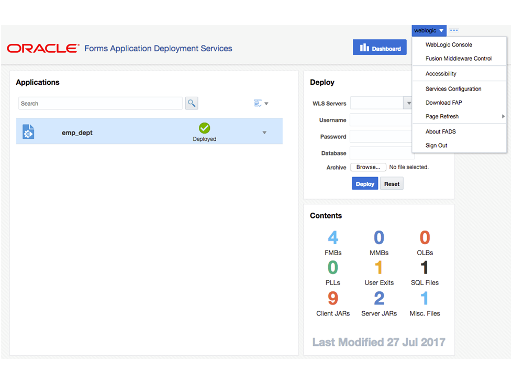4 Oracle Forms Application Deployment Services (FADS)
The Forms Application Deployment Services (FADS) simplifies the process of packaging applications, deploying, configuring, and storing archived copies of the applications.
In order to deliver and deploy a Forms application, associated modules are copied to a runtime server where they are generated into Forms executable files (fmx, mmx, plx). The process of creating the Forms executable files can be accomplished in a variety of ways, although using the provided compiler on a command line (or scripted) is most common. In addition to generating executable files, applications may also require additional custom files (for example, jars, html, etc.) and possibly unique configuration settings. For larger applications, this process may become time consuming and error prone.
The Forms Application Deployment Services allows administrators or developers to package applications, deploy, configure, and store archived copies of the applications with the click of a button. Using the FADS web interface, you can check on the status of your deployments, deploy updated versions of your applications, delete no longer needed applications, and much more. A command line interface is also available, which may be helpful for Forms build integration and scripting automated deployment jobs where using a web interface may not be appropriate.
The followings sections are included:
4.1 Installing the Forms Application Deployment Services
Follow the instructions in this section to install Forms Application Deployment Services (FADS).
Forms Application Deployment Services is available in the latest Oracle Forms and Reports 12c shiphome.
To complete the installation and begin configuring FADS, you should install the following products in the given sequence:
-
Oracle WebLogic Server 12c (12.2.1.3.0)
-
Oracle Forms and Reports 12c (12.2.1.3.0)
-
Oracle SQL Developer 4.2 (or higher)
Note:
An existing older version of SQL Developer is installed with the latest Forms and Reports 12c release. You need to rename the sqldeveloper directory located in the$ORACLE_HOME directory before installing Oracle SQL Developer 4.2 (or higher) in the same $ORACLE_HOME directory.4.2 Configuring Forms Application Deployment Services
After you have completed the installation steps, you can start configuring Forms Application Deployment Services applications.
You have to perform the following FADS application configuration steps in a Fusion Middleware domain:
Prerequisite
As a prerequisite, Repository Creation Utility Schemas must be set up for configuring Oracle Forms or FADS domain. Configuring FADS will require the Repository's User Messaging Service (UMS) and its dependencies. See Setting up RCU Schema.
4.2.1 Setting up RCU Schema
Follow the instructions in this section to set up Repository Creation Utility (RCU) schemas for configuring Oracle Forms or FADS domain.
ORACLE_HOME/oracle_common/bin directory. Follow these instructions to set up schemas.Run $FMW_HOME/oracle_common/bin/rcu.sh. Unless otherwise noted, click Next to continue to the next screen.
Table 4-1 Schema Setup Steps
| Screen | Description |
|---|---|
|
Welcome |
This screen introduces you to RCU. |
|
Create Repository |
Select Create Repository, then select System Load and Product Load (default). |
|
Database Connection Details |
Specify RCU database connection credentials. Click Next when you have specified your credentials. The Checking Prerequisites dialog window appears. It shows the progress of prerequisites checking. Click OK, when the database checking has passed without errors, to dismiss the dialog window, and go to the next screen. |
|
Select Components |
Select the Create new prefix radio button and provide a schema prefix (for example, FADSD). You must remember the prefix and schema names for the components you are installing. It is recommended that you write down these values. Select the following components:
Note: Additional dependent components will automatically be selected. The Checking Prerequisites pops up box appears. It shows the progress of prerequisites checking. Click OK, when it is complete, to dismiss the dialog window and go to the next screen. |
|
Schema Passwords |
Leave the default Use same passwords for all schemas radio button selected, and enter the password in the Password field. You must remember the passwords you enter on this screen; you need this information during the configuration phase of product installation. It is recommended that you write down these values. |
|
Map Tablespaces |
Use this screen to configure the desired tablespace mapping for the schemas that you want to setup. When you click Next, Repository Creation Utility dialog window appears, asking you to confirm that you want to create these tablespaces. Click OK to proceed and dismiss the dialog window. A second dialog window, Creating Tablespaces appears showing the progress of tablespace creation. Click OK, after the tablespaces are created, to dismiss this window and go to the next screen. |
|
Summary |
Verify the information on this screen, then click Create to begin schema setup. A System Load progress dialog window appears, showing progress. The dialog window will disappear when complete. |
|
Completion Summary |
Review the information on this screen to verify that the operation was completed successfully. Click Close to complete the schema setup and close RCU. |
4.2.2 Apply FADS Template
You have to perform specific steps by using the Configuration Wizard to apply FADS template.
You can create a new domain by selecting the FADS template in the Configuration Wizard. When you select the FADS template, it will automatically select Forms template as dependency. This will get Forms configured in the Domain along with the FADS Applications. Alternatively, you can also configure FADS in a Forms domain by applying the FADS template later.
The following topics are included:
4.2.2.1 Creating a New Domain that Includes Both Forms and FADS
Follow the steps in this topic to create a new domain by using the FADS template.
Starting the Configuration Wizard
-
Change to the following directory:
(UNIX)
ORACLE_HOME/oracle_common/common/bin(Windows)
ORACLE_HOME\oracle_common\common\binwhere
ORACLE_HOMEis your 12c Oracle home. -
Enter the following command:
(UNIX)
./config.sh(Windows)
config.cmd
Creating the Domain
In the Configuration Wizard, you have to perform the steps similar to Forms configuration, as describes in Configuring Forms Using the Configuration Wizard, but there are a few exceptions.
The following tasks performed in the Configuration Wizard screens, are not similar to the Forms configuration steps:
-
Templates screen: Select Forms Application Deployment Services (FADS) template check box, when selecting the domain template. The dependent templates, including Oracle Forms template, are automatically selected or included in the domain.
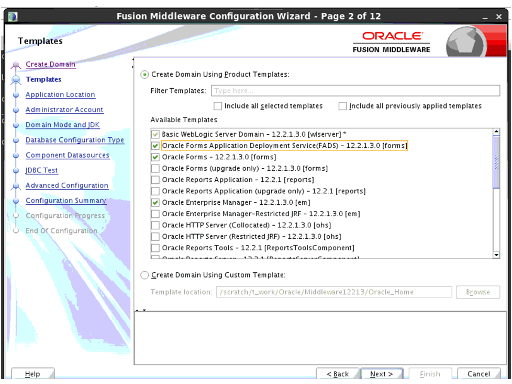
Description of the illustration fads_create-domain.png -
Advanced Configuration screen: Select the following categories: Administration Server, Topology, and System Components. For each category you select, the appropriate configuration screen is displayed to allow you to perform advanced configuration.
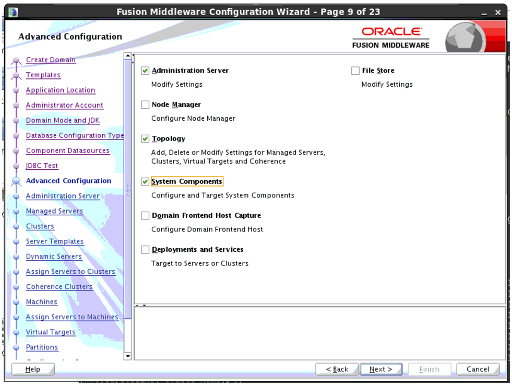
Description of the illustration fads_advanced-configuration.png -
Administration Server settings screen: Select WSMPM-MAN-SRV from the Server Groups drop-down list. The default Server Name is AdminServer.

Description of the illustration fads_administration-server.png
4.2.2.1.1 Writing Down Domain Home and Administration Server URL
The End of Configuration screen shows information about the domain just configured.
- Domain Location
- Administration Server URL
Domain location information is required for accessing scripts that start Administration Server, and URL for accessing the Administration Server.
Click Finish to exit the Configuration Wizard.
4.2.2.1.2 Starting the Administration Server
4.2.2.2 Applying FADS Template to an Existing Forms Domain
This topic describes how to use the Configuration Wizard to apply FADS extension template to an existing Forms domain.
Perform the following actions in the Configuration Wizard screens for extending an existing Forms Domain:
-
Configuration Type screen: Select Update an Existing Domain. In the Domain Location field, Enter the full path for the Forms domain, or use the Browse button to navigate to the Forms domain. This field contains a drop-down list of the domains, if multiple domains exist in the Forms installation. Select the domain that you want to update from the drop-down list. Click Next to continue.
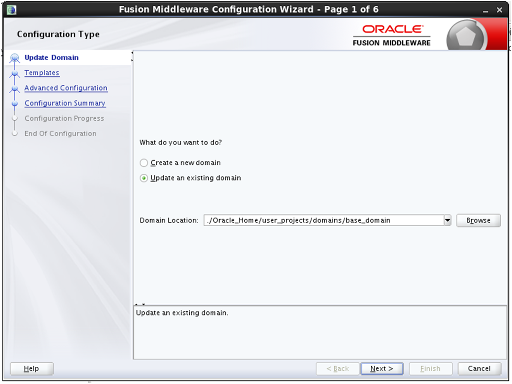
Description of the illustration fads_configuration-type.png -
Templates screen: Select Update Domain Using Product Templates, and then select the Forms Application Deployment Services (FADS) check box to add to the domain. Click Next to continue.
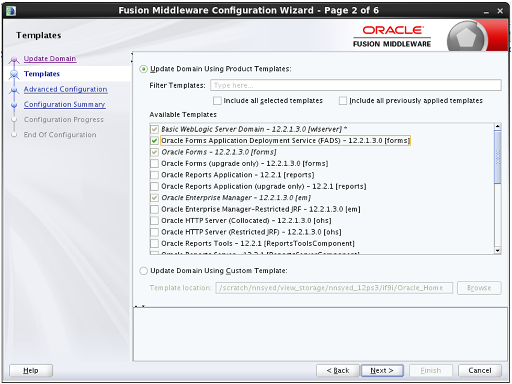
Description of the illustration fads_update-domain_templates.png -
Advanced Configuration screen: Select the Deployments and Services checkbox. For this category you would be performing advanced configuration tasks.
When extending a domain, you cannot change the Administration Server and Node Manager configurations. Therefore, these options are not available.
Click Next to continue.
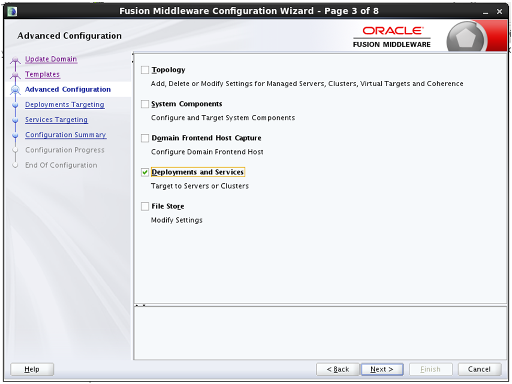
Description of the illustration fads_update-domain_adv-config.png -
Deployments Targeting screen: Target applications for deployment on servers. This screen is displayed as you selected Deployments and Services on the Advanced Configuration screen.
-
In the Deployment Targets list box, select WSM-PM application for the AppDeployment under the AdminServer.
-
If WSM-PM application is not available in Deployment Targets list box, then select it under AppDeployment on the Deployments list box and then move it to AppDeployments under AdminServer in Deployment Targets list box, using the right arrow in the top-middle.
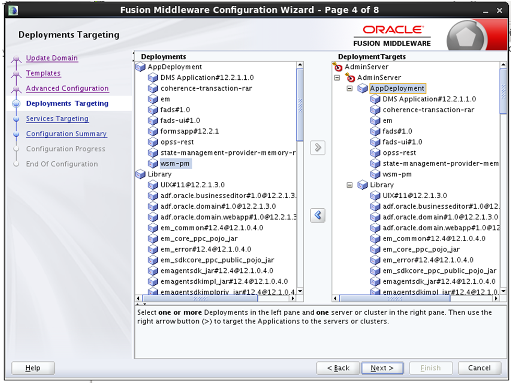
Description of the illustration fads_update-domain_deploy-targeting.png -
-
Configuration Summary screen: Review the detailed configuration settings of your domain before continuing. In the Domain Summary pane, select an item to display details about that item in the Details pane on the right. You can limit the items that are displayed in the Domain Summary pane by selecting a filter option from the Summary View drop-down list. Click Back to return to the appropriate screen, if you need to change the configuration.
Click Update to extend the domain, if the domain is configured as you want it.

Description of the illustration fads_update-domain_config-summary.png -
Configuration Progress screen: Shows the progress of the domain update. Click Next, when the process completes, .
-
End of Configuration screen: Shows information about the Forms domain you just updated.
Make a note of the following items because you need them later:
-
Domain Location
-
Administration Server URL
You need the domain location to access scripts that start Administration Server, and you need the URL to access the Administration Server. Click Finish to exit the Configuration Wizard.
-
4.2.3 Run FADS Post Configuration Script
After creating or updating your Forms domain, start the Node Manager, and then the Administration Server.
The following is an example script output:
sh-4.1$ $ORACLE_HOME/oracle_common/common/bin/wlst.sh $ORACLE_HOME/forms/fads/fads_config.py
Initializing WebLogic Scripting Tool (WLST) ...
Welcome to WebLogic Server Administration Scripting Shell
Type help() for help on available commands
----------------------------------------------------------------------
fads configuration script
----------------------------------------------------------------------
Admin Server will be shutdown by running this script.
Do you want to continue? [Y/n] :Y
You need to install Oracle SQL Developer 4.2 or higher under ORACLE_HOME. Did you install SQL Developer 4.2? [Y/n] :Y
SQL Developer 4.2 is installed under /scratch/t_work/Oracle/Middleware12213/Oracle_Home
connecting to WebLogic:
Please enter your username :weblogic
Please enter your password :
Please enter your server URL [t3://localhost:7001] :t3://www.example.com:7001
Connecting to t3://www.example.com:7001 with userid weblogic ...
Successfully connected to Admin Server "AdminServer" that belongs to domain "base_domain".
Warning: An insecure protocol was used to connect to the server.
To ensure on-the-wire security, the SSL port or Admin port should be used instead.
obtaining Admin Server host/port information
Location changed to domainRuntime tree. This is a read-only tree
with DomainMBean as the root MBean.
For more help, use help('domainRuntime')
fadsui.ear:-> /scratch/t_work/Oracle/Middleware12213/Oracle_Home/user_projects/applications/base_domain/forms/fads/fads-ui.ear
webservices - http://localhost:7001/fads/apis (updated to http://www.example.com/fads/apis)
Saving...
Totals {connections=1, rest=1, updated=1}
updating FADS OWSM policy
creating fads keystore
Already in Domain Runtime Tree
Keystore created
Already in Domain Runtime Tree
Key pair generated
Context is missing, therefore using current context "/WLS/base_domain".
Successfully configured property "keystore.type".
Successfully configured property "location".
Successfully configured property "keystore.sig.csf.key".
Successfully configured property "keystore.enc.csf.key".
creating fads WSM policy set
Session started for modification.
Description defaulted to "Global policy attachments for RESTful Resource resources."
The policy set was created successfully in the session.
Policy reference "oracle/multi_token_rest_service_policy" added.
The configuration override property "propagate.identity.context" having value "true" has been added to the reference to policy with URI "oracle/multi_token_rest_service_policy".
The policy set restPolicySet is valid.
Creating policy set restPolicySet in repository.
Session committed successfully.
importing fads authorization policy
import fadsWSpolicy passed /scratch/t_work/Oracle/Middleware12213/Oracle_Home/forms/fads/policy/fadsWSMPolicy.zip
Importing "META-INF/policies/oracle/binding_authorization_template_fads"
Successfully imported "1" documents
Location changed to edit custom tree. This is a writable tree with No root.
For more help, use help('editCustom')
Starting an edit session ...
Started edit session, be sure to save and activate your changes once you are done.
Saving all your changes ...
Saved all your changes successfully.
Activating all your changes, this may take a while ...
The edit lock associated with this edit session is released once the activation is completed.
Activation completed
shutting down the Admin Server
Shutting down the server AdminServer with force=false while connected to AdminServer ...
.Disconnected from weblogic server: AdminServer
shutting down the Admin Server
.......done with fads post configuration............
please start the Admin Server
----------------------------------------------------------------------
Exiting WebLogic Scripting Tool.
sh-4.1$
4.3 Run FADS Post Configuration Scripts after Patching
If a new Forms patch set or one-off is applied, the FADS post configuration script should be executed with the updateHostPort arguments.
Execute the FADS post configuration script with the updateHostPort arguments, as follows:
sh-4.1$ $ORACLE_HOME/oracle_common/common/bin/wlst.sh $ORACLE_HOME/forms/fads/fads_config.py updateHostPort www.example.com 7001 $ORACLE_HOME/user_projects/applications/base_domain
Initializing WebLogic Scripting Tool (WLST) ...
Welcome to WebLogic Server Administration Scripting Shell
Type help() for help on available commands
----------------------------------------------------------------------
fads configuration script
----------------------------------------------------------------------
updating host as www.example.com, and port as 7001
Start the Administration Server, then the Node Manager and the Forms Managed Servers, after completing any other patching steps.
4.4 Accessing FADS
To access FADS, WebLogic Server Administration Server must be running and accessible for FADS to work properly.
The Forms Application Deployment Services utility is deployed into the WebLogic Server Administration Server. Therefore, to access FADS the WebLogic Server Administration Server must be running and accessible in order for FADS to work properly. It is recommended that SSL be enabled on the Administration Server in order to ensure the highest degree of security. See Using Oracle Forms Services with the HTTP Listener and Oracle WebLogic Server.
To access the FADS web interface, use a URL similar to the following:
http://example.com:7001/fadsui
The default username and password to gain access to FADS is the same as the credentials used to access Fusion Middleware Control (Enterprise Manager).
4.5 Forms Applications Packager
Forms Application Packager is a Command line utility that is used to package Forms Applications Archive files, referred to as FAR files.
The Forms Application Packager searches for the Forms artifacts under the artifacts directory and generates the FAR files. These FAR files can then be deployed to the FADS services running on the latest Oracle Fusion Middleware 12c release domain.
The following topics are included:
4.5.1 Obtaining the Forms Applications Packager
The Forms Application Packager includes the scripts (fa_packager.sh and fa_packager.cmd), and its dependent libraries.
It is available in the $MW_HOME/forms/fads/fads-client directory, in current Oracle Fusion Middleware 12c release, and Oracle Forms and Reports Standalone Builder 12c installation.
You can also download the Forms Application Packager from the Forms Application Deployment Services application by navigating to the weblogic drop down menu and then select Download FAP, as shown in Figure 4-1.
4.5.2 Arguments
This topic describes the Forms Application packager arguments.
The Forms Application packager arguments should always be passed in the same order as listed in Table 4-2.
Table 4-2 Forms Application Packager Arguments
| Order | Argument | Description | Mandatory/Optional | Notes |
|---|---|---|---|---|
|
1 |
|
Forms Application name |
Mandatory |
The first argument always needs to be the Forms Application Name. Example: sales |
|
2 |
|
Forms Application version |
Mandatory |
The second argument always needs to be the Forms Application Name. This is the Forms Application version and it has not nothing to do with the Forms Product version. Example: 1.0 |
|
3 |
|
Forms Applications Artifacts directory. It is the directory where the Forms Application artifacts (Forms, Menus, PLSQL libraries, Object libraries etc.) reside. |
Mandatory |
The third argument always needs to be the artifacts directory. Avoid creating one top-level directory for all the Forms applications. Example: if you have Forms Applications Sales, Finance and Human Resources. Create a separate top-level directory for each one of these applications and pass that directory path as the artifacts directory. |
|
4 |
|
It is the directory where the FAR files are generated. |
Optional Note: When preserve_dir argument is used then output_dir becomes mandatory. |
When used, it should always be the forth argument passed to the FA packager. If you provide the output directory, then fa_packager will generate the far files under this directory. If you don’t provide this argument then fa_packger will generate the far files under the current directory. |
|
5 |
|
It is a boolean argument (true/false) with a default value of false. It indicates if the directory structure from the artifact directory needs to be preserved in the FAR files. |
Optional |
When used, it should always be the fifth argument passed to the FA packager. |
4.5.3 Forms Application Configuration
This topic describes which Forms applications related configurations can be included in the FAR file.
Forms applications related configuration can be included into the FAR file by creating the configuration contents in the files as shown in Table 4-3.
These files should be placed under the top level directory under the Forms Application artifacts directory. The Forms Application Packager will pick up the configuration from these files and include it in the FAR file. Providing these files is optional.
Table 4-3 Forms Applications Related Configuration Files
| File | Notes | Destination Forms Configuration Files |
|---|---|---|
|
|
The contents of this file will be added to formsweb.cfg during deployment by FADS.
|
|
|
|
The contents of this file will be added to a new env file during deployment by FADS.
|
|
|
|
The contents of this file will be added to jvmcontrollers.cfg during deployment by FADS. |
|
|
|
The contents of this file will be added to Registry.dat |
|
4.5.4 FAR File Contents
This topic describes the contents of the FAR files.
The contents of the FAR file which are generated by the Forms Application Packager, are shown in Table 4-4:
Table 4-4 FAR File Contents
| Name | Description |
|---|---|
|
Forms_application.xml |
It is the FADS deployment descriptor, which contains all the metadata relevant to the packaged Forms Application. |
|
fmb directory |
Includes all the Forms (fmb) files from the Forms Application artifacts directory. |
|
mmb directory |
Includes all the Menus (mmb) files from the Forms Application artifacts directory. |
|
pll directory |
Includes all the PLSQL libraries (pll) files from the Forms Application artifacts directory. |
|
olb directory |
Includes all the Object libraries (olb) files from the Forms Application artifacts directory. |
|
sql directory |
Includes all the SQL files files from the Forms Application artifacts directory. |
|
user_exits directory |
Includes all the User Exit libraries (.so and .dll for Windows platform) files from the Forms Application artifacts directory. |
|
client_jars directory |
Includes the following artifacts from the Forms Application artifacts directory:
|
|
java_importer directory |
If the Forms application has any Java Importer related jar files those should be placed under a directory named java_importer and placed under the top level directory under the Forms Application artifacts directory. |
|
misc_files directory |
Includes all Microsoft Word (*.doc, *.docx) files, Portable Document Format (*.pdf) files and Text (*.txt) files from the Forms Application artifacts directory. |
Note:
If the preserve_dir argument is passed, none of the directories, shown in Table 4-4, will be created. The sub-directories similar to the sub-directories under the artifacts directory will be created in the FAR file.4.5.5 Displaying Help
Run the Forms Application Packager without any arguments to display the help information on the terminal window.
$ ./fa_packager.sh
...................................................................
usage:
fa_packager.sh <app_name> <app_version> <artifacts_dir> <output_dir> <preserve_dir>
examples:
fa_packager.sh sales 1.0 /scratch/sales_artifacts
fa_packager.sh sales 1.0 /scratch/sales_artifacts fars
fa_packager.sh sales 1.0 /scratch/sales_artifacts fars true
notes:
arg name description
...................................................................
1. app_name : Name of the application
2. app_version : Version of the application
3. artifact_dir: Directory where Forms artifacts(fmb,mmb etc.)
are located.
4. output_dir : Directory where the far files are generated.
This argument is optional, when not provided
far files are generated in the present
directory.
5. preserve_dir: This flag indicates if the modules directory
structure under the artifacts_dir should be
preserved in the far file. Its values can be
true or false. This argument is optional,
when not provided it defaults to false.
Notes:
..................................................................
1. Create the following files and put under the top level artifact
directory to include any Forms application configuration.
app.cfg - should contain configuration that would go in formsweb.cfg
app.env - should contain configuration that would go in environment file
app_jvmcontrollers.cfg - should contain configuration that would go in jvmcontrollers.cfg
app_registry.dat - should contain configuration that would go in Registry.dat
2. When perserve_dir parameter is provided then output_dir parameter becomes mandatory.
...................................................................
$
4.6 FADS Command Line Interface (FADSCLI)
FADSCLI is the command line interface that allows users to connect and interact with the Forms Application Deployment Services running on the latest Oracle Fusion Middleware 12c domain.
FADS Command Line Interface connects to the server in non-SSL mode (that is the default mode), but you can connect to the WebLogic Administration Server SSL port by passing the additional argument ssl=true to the various FADSCLI options.
When running in SSL mode, the certificate has to be imported on the client side JVM, where you are running FADSCLI. Refer to the Java documentation on importing certificate to the Java keystore.
FADSCLI includes the FADSCLI scripts and its libraries. It is located in FMW ORACLE_HOME, in the following directory ORACLE_HOME/forms/fads/fads-client.
The following topic is included:
4.6.1 FADSCLI Options
This topic lists the options available for FADSCLI.
Table 4-5 List of FADSCLI Options
| Option | Description |
|---|---|
|
|
Displays all the Forms applications deployed to the FMW domain through the Forms Application Deployment Services. |
|
|
Displays all the Forms Application Archive (far) files that reside in the Archives Repository in Forms Application Deployment Services. |
|
|
Deploys a given Forms Application Archive (far) file to the Forms Application Deployment Services running on the FMW domain. |
|
|
It is batch mode of deployment, where it deploys all the Forms Application Archive (far) files, under a given archives directory to the Forms Application Deployment Services running on the FMW domain. |
|
|
Deploys a Forms Application Archive file residing in the Archives Repository to to the Forms Application Deployment Services running on the FMW domain. |
|
|
Undeploys / deletes a Forms application that is currently deployed to the Forms Application Deployment Services. |
|
|
Describes the contents of a Forms Application that is currently deployed to the Forms Application Deployment Services. |
|
|
Deploys a Forms Application Archive file residing in the Archives Repository |
|
|
Downloads the deployment logs of a a Forms Application that is deployed to the Forms Application Deployment Services. |
|
|
Deletes a Forms Application Archive file residing in the Archives Repository. |
Help
The following script describes Help for FADSCLI.
sh-4.1$ ./fadscli.sh
fadscli Help :
------------------------------------------------------------------------------------------------------------------------------
options | description
------------------------------------------------------------------------------------------------------------------------------
listApps | displays all the applications deployed to the FMW domain
listArchives | displays all the far files that reside in the archives repository
deployApp | deploys the far file to the FMW domain
deployApps | deploys all the far files in the local archives directory (archivedir) to the FMW domain
deployArchive | deploys the far file (archivename) from the archive repository to the FMW domain
undeployApp | undeploys/deletes the Forms application from the FMW domain
describeApp | describes the contents of an application that is deployed on the FMW domain
deleteArchive | deletes the archive from the archive repository
downloadLog | gets the deployment logs of an application that is deployed to the FMW domain
downloadArchive | downloads an archive from the archive repository
Usage :
fadscli.sh option hostname=hostname portno=portno username=username password=password
-----------------------------o-p-t-i-o-n-s-----a-r-g-u-m-e-n-t-s--------------------------------------------------------------
fadscli.sh listApps hostname=<hostname> portno=<portno> username=<username> password=<password>
fadscli.sh listArchives hostname=<hostname> portno=<portno> username=<username> password=<password>
fadscli.sh deployApp hostname=<hostname> portno=<portno> username=<username> password=<password> farfile=<path to the far file> dbuser=<dbuser> dbpassword=<dbpassword> dbalias=<dbalias> managedserver=<managedserver1,managedserver2>
fadscli.sh deployApps hostname=<hostname> portno=<portno> username=<username> password=<password> archivedir=<path to the directory containing far files> dbuser=<dbuser> dbpassword=<dbpassword> dbalias=<dbalias> managedserver=<managedserver1,managedserver2>
fadscli.sh deployArchive hostname=<hostname> portno=<portno> username=<username> password=<password> archivename=<archivename> appname=<appname> appversion=<appversion> dbuser=<dbuser> dbpassword=<dbpassword> dbalias=<dbalias> managedserver=<managedserver1,managedserver2>
fadscli.sh undeployApp hostname=<hostname> portno=<portno> username=<username> password=<password> appname=<appname> appversion=<appversion>
fadscli.sh describeApp hostname=<hostname> portno=<portno> username=<username> password=<password> appname=<appname> appversion=<appversion>
fadscli.sh deleteArchive hostname=<hostname> portno=<portno> username=<username> password=<password> archivename=<archivename> appname=<appname> appversion=<appversion>
fadscli.sh downloadLog hostname=<hostname> portno=<portno> username=<username> password=<password> appname=<appname> appversion=<appversion>
fadscli.sh downloadArchive hostname=<hostname> portno=<portno> username=<username> password=<password> archivename=<archivename> appname=<appname> appversion=<appversion>
optional argument: pass argument ssl=true when running HTTPS/SSL
------------------------------------------------------------------------------------------------------------------------------
sh-4.1$
listApps
sh-4.1$ ./fadscli.sh help listApps
listApps : displays all the applications deployed to the FMW domain
usage:
fadscli.sh listApps hostname=<hostname> portno=<portno> username=<username> password=<password>
arguments:
--------------------------------------------------------------
hostname : Weblogic Admin Server hostname
portno : Weblogic Admin Server port (ssl or non-ssl)
username : Weblogic Admin username
password : Weblogic Admin password
listArchives
sh-4.1$ ./fadscli.sh help listArchives
listArchives : displays all the far files that reside in the archives repository
usage:
fadscli.sh listArchives hostname=<hostname> portno=<portno> username=<username> password=<password>
arguments:
--------------------------------------------------------------
hostname : Weblogic Admin Server hostname
portno : Weblogic Admin Server port (ssl or non-ssl)
username : Weblogic Admin username
password : Weblogic Admin password
deployApp
sh-4.1$ ./fadscli.sh help deployApp
deployApp : deploys the far file to the FMW domain
usage:
fadscli.sh deployApp hostname=<hostname> portno=<portno> username=<username> password=<password> farfile=<path to the far file> dbuser=<dbuser> dbpassword=<dbpassword> dbalias=<dbalias> managedserver=<managedserver1,managedserver2>
arguments:
--------------------------------------------------------------
hostname : Weblogic Admin Server hostname
portno : Weblogic Admin Server port (ssl or non-ssl)
username : Weblogic Admin username
password : Weblogic Admin password
farfile : path of the far file that is to be deployed
dbuser : Forms application database username
dbpassword : Forms application database password
dbalias : Forms application database alias
managedserver : Forms Managed Servers where the Forms application should be deployed
deployApps
sh-4.1$ ./fadscli.sh help deployApps
deployApps : deploys all the far files in the local archives directory (archivedir) to the FMW domain
usage:
fadscli.sh deployApps hostname=<hostname> portno=<portno> username=<username> password=<password> archivedir=<path to the directory containing far files> dbuser=<dbuser> dbpassword=<dbpassword> dbalias=<dbalias> managedserver=<managedserver1,managedserver2>
arguments:
--------------------------------------------------------------
hostname : Weblogic Admin Server hostname
portno : Weblogic Admin Server port (ssl or non-ssl)
username : Weblogic Admin username
password : Weblogic Admin password
archivedir : local directory path containing the far files
dbuser : Forms application database username
dbpassword : Forms application database password
dbalias : Forms application database alias
managedserver : Forms Managed Servers where the Forms application should be deployed
deployArchive
sh-4.1$ ./fadscli.sh help deployArchive
deployArchive : deploys the far file (archivename) from the archive repository to the FMW domain
usage:
fadscli.sh deployArchive hostname=<hostname> portno=<portno> username=<username> password=<password> archivename=<archivename> appname=<appname> appversion=<appversion> dbuser=<dbuser> dbpassword=<dbpassword> dbalias=<dbalias> managedserver=<managedserver1,managedserver2>
arguments:
--------------------------------------------------------------
hostname : Weblogic Admin Server hostname
portno : Weblogic Admin Server port (ssl or non-ssl)
username : Weblogic Admin username
password : Weblogic Admin password
archivename : Name of the archive in archive repository
appname : Forms application name
appversion : Forms application version
dbuser : Forms application database username
dbpassword : Forms application database password
dbalias : Forms application database alias
managedserver : Forms Managed Servers where the Forms application should be deployed
undeployApp
sh-4.1$ ./fadscli.sh help undeployApp
undeployApp : undeploys/deletes the Forms application from the FMW domain
usage:
fadscli.sh undeployApp hostname=<hostname> portno=<portno> username=<username> password=<password> appname=<appname> appversion=<appversion>
arguments:
--------------------------------------------------------------
hostname : Weblogic Admin Server hostname
portno : Weblogic Admin Server port (ssl or non-ssl)
username : Weblogic Admin username
password : Weblogic Admin password
appname : Forms application name
appversion : Forms application version
describeApp
sh-4.1$ ./fadscli.sh help describeApp
describeApp : describes the contents of an application that is deployed on the FMW domain
usage:
fadscli.sh describeApp hostname=<hostname> portno=<portno> username=<username> password=<password> appname=<appname> appversion=<appversion>
arguments:
--------------------------------------------------------------
hostname : Weblogic Admin Server hostname
portno : Weblogic Admin Server port (ssl or non-ssl)
username : Weblogic Admin username
password : Weblogic Admin password
appname : Forms application name
appversion : Forms application version
deleteArchive
sh-4.1$ ./fadscli.sh help deleteArchive
deleteArchive : deletes the archive from the archive repository
usage:
fadscli.sh deleteArchive hostname=<hostname> portno=<portno> username=<username> password=<password> archivename=<archivename> appname=<appname> appversion=<appversion>
arguments:
--------------------------------------------------------------
hostname : Weblogic Admin Server hostname
portno : Weblogic Admin Server port (ssl or non-ssl)
username : Weblogic Admin username
password : Weblogic Admin password
archivename : Name of the archive in archive repository
appname : Forms application name
appversion : Forms application version
downloadLog
sh-4.1$ ./fadscli.sh help downloadLog
downloadLog : gets the deployment logs of an application that is deployed to the FMW domain
usage:
fadscli.sh downloadLog hostname=<hostname> portno=<portno> username=<username> password=<password> appname=<appname> appversion=<appversion>
arguments:
--------------------------------------------------------------
hostname : Weblogic Admin Server hostname
portno : Weblogic Admin Server port (ssl or non-ssl)
username : Weblogic Admin username
password : Weblogic Admin password
appname : Forms application name
appversion : Forms application version
downloadArchive
sh-4.1$ ./fadscli.sh help downloadArchive
downloadArchive : downloads an archive from the archive repository
usage:
fadscli.sh downloadArchive hostname=<hostname> portno=<portno> username=<username> password=<password> archivename=<archivename> appname=<appname> appversion=<appversion>
arguments:
--------------------------------------------------------------
hostname : Weblogic Admin Server hostname
portno : Weblogic Admin Server port (ssl or non-ssl)
username : Weblogic Admin username
password : Weblogic Admin password
archivename : Name of the archive in archive repository
appname : Forms application name
appversion : Forms application version
